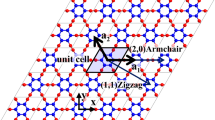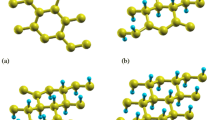Abstract
The energetic stability, atomic and electronic structures of γ-graphyne and its derivatives (γ-GYs) with extended carbon chains were investigated as a function of chain length by density functional calculations in this work. The studied γ-GYs consist of hexagon carbon rings connected by linear chains with C atoms n = 0–22. We predict that the even-numbered C chains of γ-GYs consist of alternating single and triple C-C bonds (polyyne), energetically more stable than the odd-numbered C chains made of continuous C-C double bonds (polycumulene). The calculated electronic structures indicate that γ-GYs can be either metallic (odd n) or semiconductive (even n) depending on the parity of the number of C chain atoms. The semiconducting γ-GYs are predicted to have ~1.2 eV direct band gaps and 0.1–0.2 effective electron masses independent of the chain length. Thus introducing sp carbon atoms into sp 2-based graphene provides a novel way to open up band gaps without doping and defects while maintaining small electron masses critical to good transport properties.

The typical atomic model of graphyne (middle) as well as their band gaps (left) and electron density (right)









Similar content being viewed by others
References
Kroto HW, Heath JR, O’Brien SC, Curl RF, Smalley RE (1985) C60: buckminsterfullerene. Nature 318:162–163
Iijima S (1991) Helical microtubules of graphitic carbon. Nature 354:56–58
Novoselov KS, Geim AK, Morozov SV, Jiang D, Zhang Y, Dubonos SV, Grigorieva IV, Firsov AA (2004) Electric field effect in atomically thin carbon films. Science 306:666–669
Chuvilin A, Meyer JC, Algara-Siller G, Kaiser U (2009) From graphene constrictions to single carbon chains. New J Phys 11:083019
Jin CH, Lan HP, Peng LM, Suenaga K, Iijima S (2009) Deriving carbon atomic chains from graphene. Phys Rev Lett 102:205501
Fan XF, Liu L, Lin JY, Shen ZX, Kuo JL (2009) Density functional theory study of finite carbon chains. ACS Nano 3:3788–3794
Liu MJ, Artyukhov VI, Lee H, Xu FB, Yakobson BI (2013) Carbyne from first principles: chain of C atoms, a nanorod or a nanorope. ACS Nano 7:10075–10082
Liu Y, Jones RO, Zhao XL, Ando Y (2003) Carbon species confined inside carbon nanotubes: a density functional study. Phys Rev B 68:125413
Zhao XL, Ando Y, Liu Y, Jinno M, Suzuki T (2003) Carbon nanowire made of a long linear carbon chain inserted inside a multiwalled carbon nanotube. Phys Rev Lett 90:187401
Baughman RH, Eckhardt H, Kertesz M (1987) Structure–property predictions for new planar forms of carbon: layered phases containing sp2 and sp atoms. J Chem Phys 87:6687–6699
Haley MM, Brand SC, Pak JJ (1997) Carbon networks based on dehydrobenzoannulenes: synthesis of graphdiyne substructures. Angew Chem Int Ed 36:836–838
Bunz UHF, Rubin Y, Tobe Y (1999) Polyethynylated cyclic pi-systems: scaffoldings for novel two and three-dimensional carbon networks. Chem Soc Rev 28:107–119
Diederich F, Kivala M (2010) All-carbon scaffolds by rational design. Adv Mater 22:803–812
Kehoe JM, Kiley JH, English JJ, Johnson CA, Petersen RC, Haley MM (2000) Carbon networks based on dehydrobenzoannulenes. 3. Synthesis of graphyne substructures. Org Lett 2:969–972
Marsden JA, Palmer GJ, Haley MM (2003) Synthetic strategies for dehydrobenzo n annulenes. Eur J Org Chem 2003:2355–2369
Wan WB, Haley MM (2001) Carbon networks based on dehydrobenzoannulenes. 4. Synthesis of “star” and “trefoil” graphdiyne substructures via sixfold cross-coupling of hexaiodobenzene. J Org Chem 66:3893–3901
Yoshimura T, Inaba A, Sonoda M, Tahara K, Tobe Y, Williams RV (2006) Synthesis and properties of trefoil-shaped tris(hexadehydrotribenzo 12 annulene) and tris(tetradehydrotribenzo 12 annulene). Org Lett 8:2933–2936
Kang J, Li JB, Wu FM, Li SS, Xia JB (2011) Elastic, electronic, and optical properties of two-dimensional graphyne sheet. J Phys Chem C 115:20466–20470
Narita N, Nagai S, Suzuki S, Nakao K (1998) Optimized geometries and electronic structures of graphyne and its family. Phys Rev B 58:11009–11014
Zhou J, Lv K, Wang Q, Chen XS, Sun Q, Jena P (2011) Electronic structures and bonding of graphyne sheet and its BN analog. J Chem Phys 134:174701
Li GX, Li YL, Liu HB, Guo YB, Li YJ, Zhu DB (2010) Architecture of graphdiyne nanoscale films. Chem Commun 46:3256–3258
Li GX, Li YL, Qian XM, Liu HB, Lin HW, Chen N, Li YJ (2011) Construction of tubular molecule aggregations of graphdiyne for highly efficient field emission. J Phys Chem C 115:2611–2615
Qian XM, Ning ZY, Li YL, Liu HB, Ouyang CB, Chen Q, Li YJ (2012) Construction of graphdiyne nanowires with high-conductivity and mobility. Dalton Trans 41:730–733
Du HL, Deng ZB, Lu ZY, Yin YH, Yu LL, Wu H, Chen Z, Zou Y, Wang YS, Liu HB, Li YL (2011) The effect of graphdiyne doping on the performance of polymer solar cells. Synth Met 161:2055–2057
Wang S, Yi LX, Halpert JE, Lai XY, Liu YY, Cao HB, Yu RB, Wang D, Li YL (2012) A novel and highly efficient photocatalyst based on P25-graphdiyne nanocomposite. Small 8:265–271
Long MQ, Tang L, Wang D, Li YL, Shuai ZG (2011) Electronic structure and carrier mobility in graphdiyne sheet and nanoribbons: theoretical predictions. ACS Nano 5:2593–2600
Peng Q, Ji W, De S (2012) Mechanical properties of graphyne monolayers: a first-principles study. Phys Chem Chem Phys 14:13385–13391
Zhang YY, Pei QX, Wang CM (2012) Mechanical properties of graphynes under tension: a molecular dynamics study. Appl Phys Lett 101:081909
He JJ, Ma SY, Zhou P, Zhang CX, He CY, Sun LZ (2012) Magnetic properties of single transition-metal atom absorbed graphdiyne and graphyne sheet from DFT plus U calculations. J Phys Chem C 116:26313–26321
Yue Q, Chang SL, Kang J, Tan JC, Qin SQ, Li JB (2012) Magnetic and electronic properties of alpha-graphyne nanoribbons. J Chem Phys 136:244702
Malko D, Neiss C, Vines F, Gorling A (2012) Competition for graphene: graphynes with direction-dependent Dirac cones. Phys Rev Lett 108:086804
Srinivasu K, Ghosh SK (2012) Graphyne and graphdiyne: promising materials for nanoelectronics and energy storage applications. J Phys Chem C 116:5951–5956
Zhang HY, Zhao MW, He XJ, Wang ZH, Zhang XJ, Liu XD (2011) High mobility and high storage capacity of lithium in sp-sp(2) hybridized carbon network: the case of graphyne. J Phys Chem C 115:8845–8850
Jiao Y, Du AJ, Hankel M, Zhu ZH, Rudolph V, Smith SC (2011) Graphdiyne: a versatile nanomaterial for electronics and hydrogen purification. Chem Commun 47:11843–11845
Cranford SW, Buehler MJ (2012) Selective hydrogen purification through graphdiyne under ambient temperature and pressure. Nanoscale 4:4587–4593
Zhao WH, Yuan LF, Yang JL (2012) Graphdiyne as hydrogen purification membrane. Chin J Chem Phys 25:434–440
Clark SJ, Segall MD, Pickard CJ, Hasnip PJ, Probert MJ, Refson K, Payne MC (2005) First principles methods using CASTEP. Z Krist 220:567–570
Perdew JP, Burke K, Ernzerhof M (1996) Generalized gradient approximation made simple. Phys Rev Lett 77:3865–3868
Monkhorst HJ, Pack JD (1976) Special points for Brillouin-zone integrations. Phys Rev B (Solid State) 13:5188–5192
Chengteh L, Weitao Y, Parr RG (1988) Development of the Colle-Salvetti correlation-energy formula into a functional of the electron density. Phys Rev B (Condensed Matter) 37:785–789
Clark CD, Dean PJ, Harris PV (1964) Intrinsic edge absorption in diamond. Proc R Soc London 277:312–329
Kim BG, Choi HJ (2012) Graphyne: hexagonal network of carbon with versatile Dirac cones. Phys Rev B 86:115435
Lee SH, Chung HJ, Heo J, Yang H, Shin J, Chung UI, Seo S (2011) Band gap opening by Two-dimensional manifestation of peierls instability in graphene. ACS Nano 5:2964–2969
Peierls R E (1955) Quantum theory of solids. Clarendon, Oxford
Collins AT, Williams AWS (1971) The nature of the acceptor centre in semiconducting diamond. J Phys C (Solid State Phys) 4:1789–1800
Pei Y (2012) Mechanical properties of graphdiyne sheet. Phys B 407:4436–4439
Deacon RS, Chuang KC, Nicholas RJ, Novoselov KS, Geim AK (2007) Cyclotron resonance study of the electron and hole velocity in graphene monolayers. Phys Rev B. 76 081416
Jiang Z, Henriksen EA, Tung LC, Wang YJ, Schwartz ME, Han MY, Kim P, Stormer HL (2007) Infrared spectroscopy of Landau levels of graphene. Phys Rev Lett 98:197403
Yelgel C, Srivastava GP (2012) Ab initio studies of electronic and optical properties of graphene and graphene-BN interface. Appl Surf Sci 258:8338–8342
Acknowledgments
The authors are grateful for financial supports from “Shanghai Pujiang Talent” program (12PJ1406500), “Shanghai High-tech Area of Innovative Science and Technology (14521100602)”, STCSM; “Key Program of Innovative Scientific Research” (14ZZ130) and “Key Laboratory of Advanced Metal-based Electrical Power Materials”, the Education Commission of Shanghai Municipality. X. L. thanks the Fundamental Research Funds for the Central University of China (Grant Nos. N110105001 and N120505001). X. Z. thanks National Natural Science Foundation of China (Grant Nos. 51202137, 61240054, and 11274222). Computations were done using Hujiang HPC facilities at USST, Shanghai Supercomputer Center, and National Supercomputing Center in Shenzhen, PR China.
Author information
Authors and Affiliations
Corresponding authors
Electronic supplementary material
Below is the link to the electronic supplementary material.
ESM 1
(DOCX 2689 kb)
Rights and permissions
About this article
Cite this article
Chi, B., Liu, Y., Li, X. et al. Energetic stability, atomic and electronic structures of extended γ-graphyne: A density functional study. J Mol Model 21, 154 (2015). https://doi.org/10.1007/s00894-015-2700-7
Received:
Accepted:
Published:
DOI: https://doi.org/10.1007/s00894-015-2700-7




